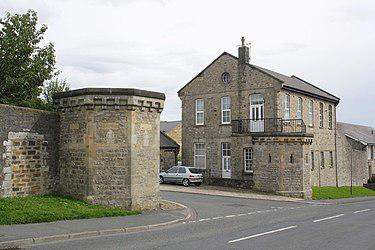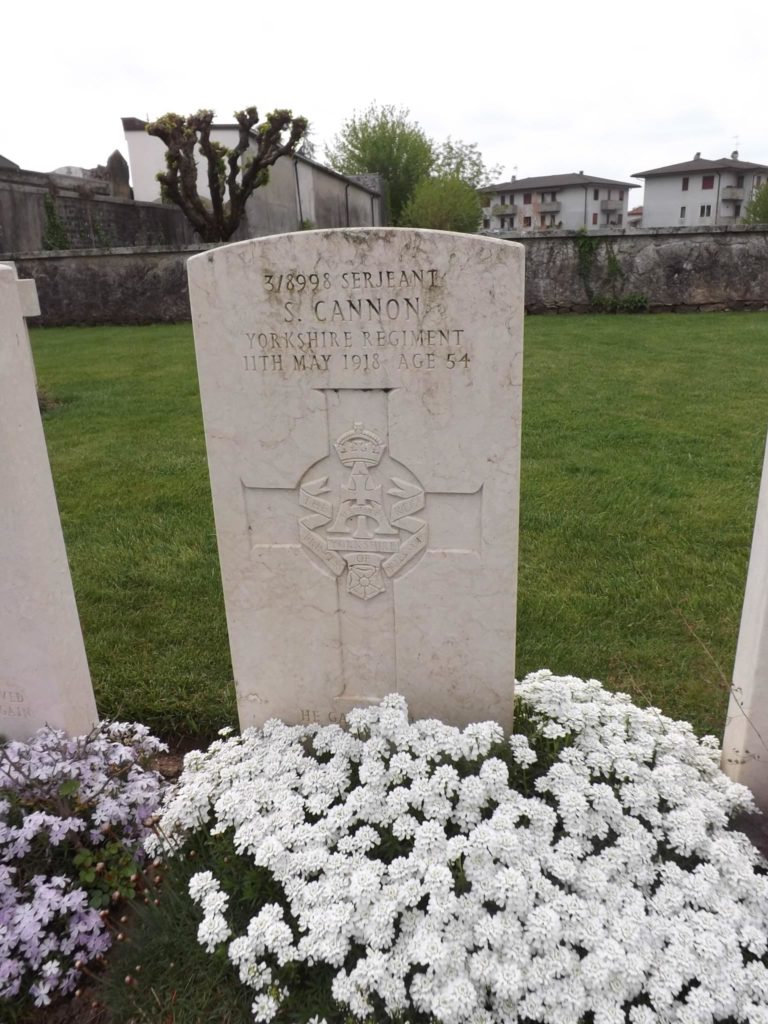
Stephen Cannon was born in Wakefield on 30th December 1865 and baptised at Thornes, St. James with Christ Church on 20th May 1866 when his family were living at Union Street, Thornes Lane. Stephen was the youngest son of seven children born to Thomas Cannon and his second wife Susan(nee Page) who married in Wakefield in July 1848. Thomas, a labourer, had three children from his first marriage to Caroline Dobson (1820-1846) at Horbury in August 1842.
By 1881 Stephen was fifteen years old and living on Wakefield Kirkgate where his father had a green grocer’s shop and Stephen was a packer at a soap works. The household had three lodgers including a silk hat maker from Ipswich. Then Stephen’s life changed. His father died in 1882 and three years later just four days after his 19th birthday he passed his medical at Pontefract and on 6th January 1885 as Private 1294 S. Cannon he joined The Yorkshire Regiment for twelve years. He had been in the militia earlier even than 1885 when he had served with the 3rd Volunteer Battalion West York Regiment, probably from the age of seventeen.
Aged just 19 years Stephen was 5’5 ¾ in” tall, weighed in at 126lbs with a fresh complexion, blue eyes, brown hair, good physical development and no smallpox marks. His only distinguishing mark was a “blue dot on his left forearm”. He took up his duties with the Yorkshire Regiment at their Depot at Richmond Barracks and in September 1885 he was appointed Drummer but it was not for him and he reverted to Private Cannon the following May.
 Entrance towers to the Yorkshire Regiment barracks in Richmond built 1875-1877.
Entrance towers to the Yorkshire Regiment barracks in Richmond built 1875-1877.
In June 1886 he was appointed Lance Corporal received good conduct pay in February 1887 and was promoted to Corporal rank in the following October. He held that position until, having served four years and 220 days, in August 1889 he was “discharged by purchase of £18”. He had bought himself out for the equivalent of almost £ 2500 in current (2021) values.
The reason for the buyout of his service for a not inconsequential sum is unknown but in Richmond in summer 1888 Stephen had married Nottinghamshire born Mary Blatherwick. Had he remained with the Yorkshire Regiment he would have been required to serve another two years and 145 days and gone into Reserve for a further five years. Perhaps that future wasn’t for them. Even so 25 years later his army service record indicates that on 14th September 1914 he re-enlisted as service no. 8998 from Special Reserve and joined the 8th battalion of The Yorkshire Regiment. We shall hear more of this.
Stephen Cannon was back on Civvy Street in August 1889, albeit with two Education Certificates courtesy of the Yorkshire Regiment. In spring 1890 the couple’s first child, Frederick was born in Stephen’s home town, Wakefield, and by 1891 the family had moved to Spring Gardens, Earlsheaton where Stephen ran a confectioner’s shop.
In the late 1890’s and now with four children the family moved to Dale Street Ossett where Stephen worked as a clerk in a rag workhouse and his wife Mary was a self employed retailer of baby linen. The couple had another child born in Ossett in 1905 and by 1911 the family moved to live at Bank Street, Guisborough where Stephen worked as an ironstone miner.
Since leaving the army Stephen Cannon had worked in three jobs in twenty years. On 4th August 1914 Great Britain declared war on the German Empire and on 14th September 1914 Stephen Cannon, of Belmangate, Guisborough, enlisted and joined the 8th battalion Yorkshire Regiment. This was his last view of the town in which he lived with his wife and four children as he went to war in August 1915. He was almost 50 years of age.
Belmangate, Guisborough courtesy of The Walter Brelstaff Archive.
The full title of The Yorkshire Regiment is Alexandra, Princess of Wales’ Own Regiment, also known as The Green Howards.
Stephen Cannon, service number 8998 joined the 8th (Service) Battalion and was with them when it was formed at Richmond on 22nd September 1914. In October the Regiment was attached to the 69th Brigade in the 23rd Division. It moved to Frensham in Hampshire and in February 1915 went on to Folkestone, Maidstone and Shorncliffe in Kent. On 26th August 1915 the 8th (Service) Battalion landed at Boulogne-sur-Mer as part of the 69th Brigade in the 23rd Division and proceeded to the concentrate near Tilques. In November 1917 the Division moved to Italy.
On 5th September 1915 the Division moved to the Merris-Vieux Berquin area, where trench familiarisation began. The Division took responsibility for a frontline sector for the first time nine days later, taking over between Ferme Grande Flamengrie to the Armentieres-Wez Macquart road. At this time, the 23rd Division was holding the front at Bois Grenier and remained in this area for a considerable time. It was to be Stephen Cannon’s first experience of trench warfare.
In 1916 the Division was relieved after a lengthy five months spell in the front line by 34th Division, between 26th January and 8th February 1916. The units then concentrated around Bruay.
On 3rd March 1916 orders were received to relieve the French in the Carency sector where it was instructed to hold the front line. Artillery was located in the area of Carency, an exposed position in which it was subject to severe shelling. In early March many former miners were withdrawn from the ranks to establish a Royal Engineers Tunnelling Company. The Division was relieved by 2nd Division between 12th and 19th April and withdrew to Bruay area and later were moved back into the Souchez-Angres front in early May.
The enemy attack on Vimy Ridge on 21 May fell most heavily on 47th (London) Division, which was to the 23rd Division’s right in the area of Berthonval. Shellfire fell heavily around Aix Noulette from 4.30pm. The Division was relieved on 11 June and moved to Bomy for intensive training.
Thereafter in 1916 France the Division took part in the major engagements on The Somme including The Battles at Albert, Bazentin Ridge, Pozieres, Flers-Courcelette, Morval and Le Transloy.
As 1916 France turned into 1917 Belgium /Ypres there was more of the same for Stephen Cannon with the Battle of Messines, Menin Road, Polygon Wood and Passchendaele twice. The Second Battle of Passchendaele.
On 28 October 1917 the exhausted Division was ordered to make ready to move by rail, and on 31st October the destination was confirmed as Italy where it then remained. It completed concentration between Mantua and Marcaria on 16th November and took over the front line at the Montello on 4th December. It was no bed of roses and the Division lost many men killed and wounded mostly due to artillery and air attack, comparatively small numbers compared to their experiences at Flanders.
In May 1918 men began to fall sick with influenza which swept through the Division. On 11th May 1918 Serjeant Stephen Cannon breathed his last as the result of an accident whilst he was on active service. No more is known and the Regimental War Diaries for that period appear not to have survived. During the war the 23rd Division lost 23574 men killed, wounded and missing. Serjeant Stephen Cannon was one of those lost. He died on 1918 aged 54 years.
Stephen Cannon was posthumously awarded the British and Allied medals for their service in a theatre of war and the 1914-15 Star for serving on or before 31st December 1915.
Stephen Cannon was 54 years of age and left a widow Mary and five children, three of whom were living with their mother at Guisborough in 1921.
Serjeant Stephen Cannon, 3/8998, 8th Battalion Yorkshire Regiment died as a result of an accident whilst on active service on 11th May 1918 and is remembered with honour by the Commonwealth War Graves Commission at Dueville Communal Cemetery Extension, Italy
The Italians entered the war on the Allied side, declaring war on Austria, in May 1915. Commonwealth forces were at the Italian front between November 1917 and November 1918, and rest camps and medical units were established at various locations in northern Italy behind the front, some of them remaining until 1919. From April 1918 to the early months of 1919, the 9th, 24th and 39th Casualty Clearing Stations occupied the village school at Dueville and used the extension to the communal cemetery for the burial of those who died of wounds or disease. Stephen Cannon will be remembered at Ossett War Memorial in 2022 alongside his brothers and sisters in arms; The Ossett Fallen.



He is also remembered at the Guisborough War Memorial. One of the panels bears his name (Left)
Identification and biography courtesy of the Ossett War Memorial Team. February 2022.